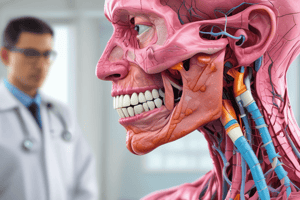Podcast
Questions and Answers
What is the primary cause of Tumor Lysis Syndrome?
What is the primary cause of Tumor Lysis Syndrome?
- Cancer cells growing out of control
- A paraneoplastic syndrome caused by the tumor's hormonal production
- A treatment-related complication caused by radiation therapy
- The rapid destruction of cancer cells due to chemotherapy (correct)
What type of oncologic emergency is characterized by the compression of the spinal cord?
What type of oncologic emergency is characterized by the compression of the spinal cord?
- Treatment-related complications
- Metabolic or hormonal problems
- Mechanical or Obstructive problems (correct)
- Malignant Effusions
What is the term for a group of disorders that occur when a cancerous tumor produces hormones or other substances that affect distant organs?
What is the term for a group of disorders that occur when a cancerous tumor produces hormones or other substances that affect distant organs?
- Tumor Lysis Syndrome
- Paraneoplastic Syndromes (correct)
- Mechanical or Obstructive problems
- Metabolic or hormonal problems
What is the term for a blockage of the superior vena cava, which is a major vein that carries blood from the upper body to the heart?
What is the term for a blockage of the superior vena cava, which is a major vein that carries blood from the upper body to the heart?
A patient with cancer in the liver most likely has a metastatic cancer from another organ, which is an example of what type of oncologic emergency?
A patient with cancer in the liver most likely has a metastatic cancer from another organ, which is an example of what type of oncologic emergency?
Which type of cancer is most likely to be associated with paraneoplastic syndromes?
Which type of cancer is most likely to be associated with paraneoplastic syndromes?
What is the clinical manifestation of superior vena cava (SVC) obstruction?
What is the clinical manifestation of superior vena cava (SVC) obstruction?
What is the most common site of malignant spinal cord compression?
What is the most common site of malignant spinal cord compression?
What is the primary treatment for SVCS caused by non-small-cell lung cancer and other metastatic solid tumors?
What is the primary treatment for SVCS caused by non-small-cell lung cancer and other metastatic solid tumors?
What is the mechanism of hypercalcemia caused by cytokine disruption in cancer patients?
What is the mechanism of hypercalcemia caused by cytokine disruption in cancer patients?
What is the diagnostic test of choice for evaluating spinal cord compression in patients with cancer?
What is the diagnostic test of choice for evaluating spinal cord compression in patients with cancer?
What is the corrected calcium formula in patients with cancer?
What is the corrected calcium formula in patients with cancer?
What is the characteristic physical finding in patients with Superior Vena Cava Syndrome?
What is the characteristic physical finding in patients with Superior Vena Cava Syndrome?
What is the primary goal of treatment in patients with Spinal Cord Compression?
What is the primary goal of treatment in patients with Spinal Cord Compression?
What is the common symptom of Hypercalcemia that can be differentiated from disk disease?
What is the common symptom of Hypercalcemia that can be differentiated from disk disease?
Why is the calcium level not a reliable indicator of hypercalcemia in cancer patients?
Why is the calcium level not a reliable indicator of hypercalcemia in cancer patients?
What is the initial step in emergency management of hypercalcemia?
What is the initial step in emergency management of hypercalcemia?
Why is treatment of hypercalcemia less vigorous in patients with late-stage, resistant tumors?
Why is treatment of hypercalcemia less vigorous in patients with late-stage, resistant tumors?
What is the predictable consequence of cytotoxic chemotherapeutic agents on bone marrow function?
What is the predictable consequence of cytotoxic chemotherapeutic agents on bone marrow function?
What is the clinical presentation of febrile neutropenia?
What is the clinical presentation of febrile neutropenia?
What is the primary goal of treating hypercalcemia in patients with a good chance of effective tumor therapy?
What is the primary goal of treating hypercalcemia in patients with a good chance of effective tumor therapy?
What is the primary reason why patients with a known cancer diagnosis may experience a common oncologic emergency condition?
What is the primary reason why patients with a known cancer diagnosis may experience a common oncologic emergency condition?
What is the primary concern when a patient with cancer is experiencing Tumor Lysis Syndrome?
What is the primary concern when a patient with cancer is experiencing Tumor Lysis Syndrome?
Which of the following oncologic emergencies is classified as a metabolic or hormonal problem?
Which of the following oncologic emergencies is classified as a metabolic or hormonal problem?
What is the characteristic of cancer in the liver?
What is the characteristic of cancer in the liver?
What is the primary reason for the clinical presentation of superior vena cava syndrome?
What is the primary reason for the clinical presentation of superior vena cava syndrome?
What is the primary benefit of treating hypercalcemia vigorously in patients with a good chance of effective tumor therapy?
What is the primary benefit of treating hypercalcemia vigorously in patients with a good chance of effective tumor therapy?
Which type of cancer is most likely to cause paraneoplastic syndromes?
Which type of cancer is most likely to cause paraneoplastic syndromes?
Why is IV 0.9% saline used in the emergency management of hypercalcemia?
Why is IV 0.9% saline used in the emergency management of hypercalcemia?
What is the primary treatment for superior vena cava syndrome caused by non-small-cell lung cancer and other metastatic solid tumors?
What is the primary treatment for superior vena cava syndrome caused by non-small-cell lung cancer and other metastatic solid tumors?
What is the predictable consequence of cytotoxic chemotherapeutic agents on bone marrow function?
What is the predictable consequence of cytotoxic chemotherapeutic agents on bone marrow function?
What is the mechanism of hypercalcemia caused by vitamin D–mediated osteoabsorption?
What is the mechanism of hypercalcemia caused by vitamin D–mediated osteoabsorption?
What is the primary reason why the calcium level is not a reliable indicator of hypercalcemia in cancer patients?
What is the primary reason why the calcium level is not a reliable indicator of hypercalcemia in cancer patients?
What is the primary goal of treating hypercalcemia in patients with late-stage, resistant tumors?
What is the primary goal of treating hypercalcemia in patients with late-stage, resistant tumors?
What is the corrected calcium formula in patients with cancer?
What is the corrected calcium formula in patients with cancer?
What is the characteristic presentation of febrile neutropenia?
What is the characteristic presentation of febrile neutropenia?
What is the characteristic physical finding in patients with superior vena cava syndrome?
What is the characteristic physical finding in patients with superior vena cava syndrome?
What is the common symptom of hypercalcemia that can be differentiated from disk disease?
What is the common symptom of hypercalcemia that can be differentiated from disk disease?
Flashcards are hidden until you start studying
Study Notes
Oncologic Emergencies
- Oncologic emergencies are classified into three groups: mechanical/obstructive, metabolic/hormonal, and treatment-related complications.
- Patients can present with a common oncologic emergency condition, leading to a cancer diagnosis.
Classifications of Oncologic Emergencies
Mechanical/Obstructive
- SVCS (Superior Vena Cava Syndrome)
- MSCC (Malignant Spinal Cord Compression)
- Neutropenia
- Tumor Lysis Syndrome
Metabolic/Hormonal
- Hypercalcemia
- SIADH (Syndrome of Inappropriate Antidiuretic Hormone)
- Bleeding Disorders
- Malignant Effusions
- Paraneoplastic Syndromes
Treatment-Related
- Anemia
- Pulmonary Embolism
- Thrombocytopenia
- Urinary Obstruction
- Clotting Disorders
Paraneoplastic Syndromes
- General problems observed in many patients with advanced or widespread metastatic cancer include anorexia, malaise, and weight loss.
- Symptoms are due to aberrant tumor production of hormones, peptides, or cytokines or to the body’s immune attack on normal tissues due to shared antigens with tumor tissues.
- Small cell lung cancer (SCLC) is the one type of cancer most likely to be associated with paraneoplastic syndromes.
Superior Vena Cava Syndrome (SVCS)
Pathophysiology
- SVCS is the clinical manifestation of superior vena cava (SVC) obstruction.
- Malignant tumors (lung cancer, lymphoma, metastatic tumors) are responsible for the majority of SVCS cases.
Presentation
- Patients present with neck and facial swelling, dyspnea, and cough.
- Other symptoms include hoarseness, tongue swelling, headaches, nasal congestion, epistaxis, hemoptysis, dysphagia, pain, dizziness, syncope, and lethargy.
Diagnostic Workup
- Diagnosis of SVCS is clinical.
- Chest radiograph (CXR) is the first step, showing widening of the superior mediastinum.
- CT provides the most reliable view of the mediastinal anatomy.
Treatment
- Radiation therapy is the primary treatment for SVCS caused by non-small-cell lung cancer and other metastatic solid tumors.
- Diuretics with a low-salt diet, head elevation, and supplemental oxygen may produce temporary symptomatic relief.
Spinal Cord Compression (MSCC)
Pathophysiology
- MSCC is defined as compression of the spinal cord and/or cauda equina by an extradural tumor mass.
- Thoracic spine is the most common site (70%), followed by lumbosacral spine (20%), and cervical spine (10%).
Presentation
- Most common initial symptom is localized back pain and tenderness.
- Pain is exacerbated by movement and by coughing or sneezing and can be differentiated from the pain of disk disease by the fact that it worsens when the patient is supine.
Diagnostic Workup
- Patients with cancer who develop back pain should be evaluated for MSCC as quickly as possible.
- Plain films of the spine and MRI are used in diagnosis.
Treatment
- Treatment is aimed at relief of pain and restoration/preservation of neurologic function.
- Management requires a multidisciplinary approach.
- Radiation therapy plus glucocorticoids is the initial treatment of choice for most patients with MSCC.
Hypercalcemia
Pathophysiology
- Elevated levels of calcium in the blood (>10.5 mg/dL).
- Hypercalcemia affects 20–30% of patients with cancer at some point during their illness.
- Most common cancers causing hypercalcemia are myeloma, breast carcinoma, and NSCLC.
Presentation
- Symptoms and signs can be subtle; more severe symptoms occur with higher levels of hypercalcemia and with a rapidly rising calcium level.
- Early symptoms include anorexia, nausea, fatigue, constipation, and polyuria.
Diagnostic Workup
- Corrected calcium level is calculated to account for low albumin levels in cancer patients.
- Ionized calcium level is a more specific and sensitive test.
- ECG in hypercalcemia often shows a shortening of the QT interval.
Treatment
- Emergency management begins with IV 0.9% saline to ensure rehydration with brisk urinary output.
- For moderate or severe hypercalcemia, treatment with bisphosphonate is indicated.
- Treatment is then directed to control of the tumor; reduction of tumor mass usually corrects hypercalcemia.
Oncologic Emergencies
- Oncologic emergencies are classified into three groups: mechanical/obstructive, metabolic/hormonal, and treatment-related complications.
- Patients can present with a common oncologic emergency condition, leading to a cancer diagnosis.
Classifications of Oncologic Emergencies
Mechanical/Obstructive
- SVCS (Superior Vena Cava Syndrome)
- MSCC (Malignant Spinal Cord Compression)
- Neutropenia
- Tumor Lysis Syndrome
Metabolic/Hormonal
- Hypercalcemia
- SIADH (Syndrome of Inappropriate Antidiuretic Hormone)
- Bleeding Disorders
- Malignant Effusions
- Paraneoplastic Syndromes
Treatment-Related
- Anemia
- Pulmonary Embolism
- Thrombocytopenia
- Urinary Obstruction
- Clotting Disorders
Paraneoplastic Syndromes
- General problems observed in many patients with advanced or widespread metastatic cancer include anorexia, malaise, and weight loss.
- Symptoms are due to aberrant tumor production of hormones, peptides, or cytokines or to the body’s immune attack on normal tissues due to shared antigens with tumor tissues.
- Small cell lung cancer (SCLC) is the one type of cancer most likely to be associated with paraneoplastic syndromes.
Superior Vena Cava Syndrome (SVCS)
Pathophysiology
- SVCS is the clinical manifestation of superior vena cava (SVC) obstruction.
- Malignant tumors (lung cancer, lymphoma, metastatic tumors) are responsible for the majority of SVCS cases.
Presentation
- Patients present with neck and facial swelling, dyspnea, and cough.
- Other symptoms include hoarseness, tongue swelling, headaches, nasal congestion, epistaxis, hemoptysis, dysphagia, pain, dizziness, syncope, and lethargy.
Diagnostic Workup
- Diagnosis of SVCS is clinical.
- Chest radiograph (CXR) is the first step, showing widening of the superior mediastinum.
- CT provides the most reliable view of the mediastinal anatomy.
Treatment
- Radiation therapy is the primary treatment for SVCS caused by non-small-cell lung cancer and other metastatic solid tumors.
- Diuretics with a low-salt diet, head elevation, and supplemental oxygen may produce temporary symptomatic relief.
Spinal Cord Compression (MSCC)
Pathophysiology
- MSCC is defined as compression of the spinal cord and/or cauda equina by an extradural tumor mass.
- Thoracic spine is the most common site (70%), followed by lumbosacral spine (20%), and cervical spine (10%).
Presentation
- Most common initial symptom is localized back pain and tenderness.
- Pain is exacerbated by movement and by coughing or sneezing and can be differentiated from the pain of disk disease by the fact that it worsens when the patient is supine.
Diagnostic Workup
- Patients with cancer who develop back pain should be evaluated for MSCC as quickly as possible.
- Plain films of the spine and MRI are used in diagnosis.
Treatment
- Treatment is aimed at relief of pain and restoration/preservation of neurologic function.
- Management requires a multidisciplinary approach.
- Radiation therapy plus glucocorticoids is the initial treatment of choice for most patients with MSCC.
Hypercalcemia
Pathophysiology
- Elevated levels of calcium in the blood (>10.5 mg/dL).
- Hypercalcemia affects 20–30% of patients with cancer at some point during their illness.
- Most common cancers causing hypercalcemia are myeloma, breast carcinoma, and NSCLC.
Presentation
- Symptoms and signs can be subtle; more severe symptoms occur with higher levels of hypercalcemia and with a rapidly rising calcium level.
- Early symptoms include anorexia, nausea, fatigue, constipation, and polyuria.
Diagnostic Workup
- Corrected calcium level is calculated to account for low albumin levels in cancer patients.
- Ionized calcium level is a more specific and sensitive test.
- ECG in hypercalcemia often shows a shortening of the QT interval.
Treatment
- Emergency management begins with IV 0.9% saline to ensure rehydration with brisk urinary output.
- For moderate or severe hypercalcemia, treatment with bisphosphonate is indicated.
- Treatment is then directed to control of the tumor; reduction of tumor mass usually corrects hypercalcemia.
Studying That Suits You
Use AI to generate personalized quizzes and flashcards to suit your learning preferences.




